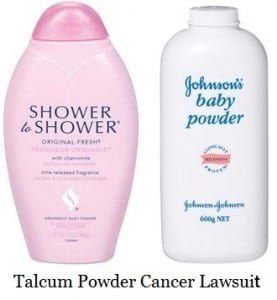 (Dec. 12, 2018) A Reuters story this week shows Johnson & Johnson knew for decades that its baby powder was contaminated with asbestos. Newly unearthed records show the company typically did not know – and plaintiff’s lawyers in several talc cancer lawsuits have argued the company did not want to know – exactly how much asbestos was contained in each batch. Nevertheless, this latest Reuters research strongly suggests, and some would say “proves,” what several plaintiffs’ lawyers have argued in the courts – that J&J knew some of its talcum batches were contaminated with carcinogenic asbestos.
(Dec. 12, 2018) A Reuters story this week shows Johnson & Johnson knew for decades that its baby powder was contaminated with asbestos. Newly unearthed records show the company typically did not know – and plaintiff’s lawyers in several talc cancer lawsuits have argued the company did not want to know – exactly how much asbestos was contained in each batch. Nevertheless, this latest Reuters research strongly suggests, and some would say “proves,” what several plaintiffs’ lawyers have argued in the courts – that J&J knew some of its talcum batches were contaminated with carcinogenic asbestos.
Though the company has successfully turned back some talc-cancer lawsuits, it has lost more jury verdicts than it has won. Going forward, the difference now may be that Reuters has turned up the evidence that some juries have found lacking in some of the talc-cancer trials against Johnson & Johnson. The company has thus far been able to keep juries from seeing most of this latest uncovered evidence of its internal communications regarding asbestos-tainted talc.
A Potential Game Changer
The internal documents Reuters just unearthed present a potential game changer for talc litigants. The documents which Reuters turned up show that J&J has known of its talc-asbestos contamination problem for at least 60 years. The documents show J&J has been aware – at least since the late 1950s – of an asbestos-contaminated talcum problem.
In addition, the internal documents show J&J officials knew their talcum powder was sometimes tainted with carcinogenic asbestos, yet they kept that information from regulators and the public.
J&J documents Unavailable to Plaintiff
In one lawsuit directed against J&J for alleged talc-related ovarian cancer, 52-year-old Darlene Coker filed suit against the company. Ms. Coker believed her mesothelioma was caused by her longtime use of J&J talcum powder. She hadn’t worked in ship building, mining, manufacturing, or in any other industry which employs people prone to developing the deadly disease. Ms. Coker ran a massage school in Lumberton, Texas. How had she been exposed to asbestos?
Darlene Coker sued Johnson & Johnson in 1999, alleging “poisonous talc” in the company’s flagship product gave her mesothelioma, which would eventually kill her at age 63.
J&J denied the claim. Its attorneys argued that J&J Baby Powder was asbestos-free. As the case progressed, company attorneys were able to convince the judge not to make them hand over talc test results and other internal company records which the plaintiff demanded. Without that evidence, Ms. Coker was forced to drop her lawsuit. Without those documents, her lawyer could not establish the burden of proof placed by law on every plaintiff.
Nearly 20 years later, the evidence Ms. Coker needed is emerging. J&J has now been compelled to share thousands of pages of company memos, internal reports and other confidential documents with plaintiffs’ lawyers who represent some 11,700 plaintiffs who claim J&J talc caused their cancers. Thousands of those women have ovarian cancer.
J&J Talc Tested Positive for Asbestos
Reuters examination of many of those documents, as well as deposition and trial testimony, show that from at least 1971 to the early 2000s, J&J’s raw talc and finished powders sometimes tested positive for small amounts of asbestos, though the company tested just a tiny portion of its powders. Meanwhile, J&J executives, mine managers, scientists, doctors, and lawyers fretted over the problem and how to address it. And all the while they failed to disclose their concerns to regulators or the public.
J&J silenced Regulators
The documents also show J&J’s successful efforts to influence U.S. regulators’ plans to limit asbestos in cosmetic talc products, and limit scientific research on the health effects of talc.
Previous Trials lacked this evidence
Lawyers for plaintiffs in several talc-cancer trials so far have been able to present only a small portion of the documents the Reuters study has unearthed. J&J has been able to keep many documents from public view by court orders that allowed the company to turn over thousands of documents it designated as “confidential.”
They are confidential no more, at least not to the public. Reuters reports much of their contents for the first time. Reuters found that J&J first mentioned talc-asbestos contamination in 1957 and 1958 reports from a consulting lab. Those reports described contaminants in talc from J&J’s Italian supplier as fibrous and “acicular,” or needle-like, tremolite. Tremolite is one of the six minerals classified as asbestos in their naturally occurring fibrous form.
From those late 1950 to the early 2000s, reports by scientists at J&J, outside labs and J&J’s supplier found similar results. Those reports identified contaminants in talc and finished powder products as asbestos or describe them in terms typically applied to asbestos, such as “fiberform” and “rods.”
J&J Fails to Inform FDA of Talc-Asbestos Contamination
In one more bombshell from the documents, when the FDA was weighing limits on asbestos in cosmetic talc products, J&J assured FDA that no asbestos was “detected in any sample” of talc produced from December 1972 to October 1973. J&J failed to tell FDA that at least three tests by three different labs from 1972 to 1975 had found asbestos in its talc – in one case at levels reported as “rather high.”
Whether this newly released information will find its way into the court rooms in this litigation is uncertain. For now, it is enough to give those litigants hope who believe their ovarian cancer or mesothelioma was caused by exposure to J&J talc products.
Johnson & Johnson Response
Johnson & Johnson, meanwhile, says that releasing these documents shows the care the company takes to ensure its products are asbestos free. J&J says it will appeal the recent verdicts against it. The company has maintained in public statements that its talc is safe. It says years of the best tests available show its talc is safe.
J&J has blamed its losses on juror confusion, “junk” science, unfair court rules, plaintiffs’ attorneys. J&J’s vice president of global media relations, Ernie Knewitz, emailed a response to Reuters’ findings: “Plaintiffs attorneys out for personal financial gain are distorting historical documents and intentionally creating confusion in the courtroom and in the media. This is all a calculated attempt to distract from the fact that thousands of independent tests prove our talc does not contain asbestos or cause cancer. Any suggestion that Johnson & Johnson knew or hid information about the safety of talc is false.”
Reuter’s reported that it tried for more than two months to have Johnson & Johnson executives comment further for this latest article. The executives refused. J&J did tell Reuters it would have one of its experts contact the news agency, but no J&J expert contacted Reuters for nearly a week. Finaly, one J&J expert said that he would not comment.
Johnson & Johnson referred all inquiries to its outside litigation counsel, Peter Bicks. In responses emailed to Reuters, Mr. Bicks rejected the new agency’s findings as “false and misleading.”
“The scientific consensus is that the talc used in talc-based body powders does not cause cancer, regardless of what is in that talc,” wrote Mr. Bicks. “This is true even if – and it does not – Johnson & Johnson’s cosmetic talc had ever contained minute, undetectable amounts of asbestos.” Mr. Bicks dismissed tests cited in this article as “outlier” results.
Talc Asbestos Cancer Lawsuits
Nearly 12,000 talc asbestos cancer lawsuits have now been filed across the country.
Related
- Reuters: J&J knew of Talc Contamination
- Talcum Powder Cancer Attorney
- Talcum Powder Cancer Lawsuit
- J&J ordered to Pay $47 Million for Talc Powder Cancer

by Matthews & Associates




